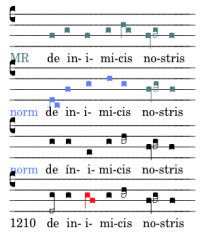Benutzer-Werkzeuge
🔘 IN GR TR AL OF CO xxxxx ✅ 2️⃣ 0️⃣ 3️⃣ 4️⃣ 5️⃣ 6️⃣ 7️⃣ 8️⃣ xxxxx AN RP IV alia
1210 AN Per signum crucis 1.M.Modus 1
↖️
2INC cad +
FML PeCl „crucis“
1NOV typ variatio. in MR 1MED triv, item variatio.
1TER v.add.

„Per signum crucis“
Bv weitet den Text aus und hat so genügend Silben für einen klassischen vierteiligen Typ des 1.Modus. Die anderen Quellen müssen mit 5 Silben zurechtkommen. Nimmt man die VrgStr auf der ersten Silbe ernst, so muss sie ein „re“ sein (AM!) und den Cento 1INC VrgStr einleiten. Auch der Schluss des Cento mit PeCl an Stelle des finalen „re“ steht außer Frage. Bleiben die beiden Silben „sig-num“ übrig. Unterlegt man den kürzesten Cento 1INC VrgStr (0269), es bleiben die Töne „do-re-fa-mi“ über. Das „mi“ ist durch den Cephalicus „sig-num“ verhindert, für den kPes bleiben die Töne „do-re“ über.
MR spielt hier nicht mit: die zweite Virga ist kürzer als die erste. Trotz VrgStr (Oriscus applicatus) ist der erste Ton „fa“ (Wc). Interessant ist der Kompromiss in Ka.
 „crucis“ Der Pressus ist Zeichen für den Centowechsel.
„crucis“ Der Pressus ist Zeichen für den Centowechsel.
„de inimicis nostris“ Die Binnenposition dieser Antiphon könnte mit 1MEDtriv veront sein (norm1) oder 1NOV typ (norm2). Tatsächlich ist sie ein Variation von 1NOV typ. Am Ende ist bei „nostris - libera“ das 'equaliter' Zeichen für den Centowechsel.
„líbera nós deus noster“ ist eine klassische 1TER v.add, die mit einem zusätzlichen nkPes eingeleitet wird. Die Clv auf dem Personalpronomen „nos“ ist mit Episem hervorgehoben (nkClv).
● Durch das Kreuzeszeichen von unseren Feinden befreie uns, unser Gott, Halleluja.
● Through the sign of the cross from our enemies deliver us, our God, alleluia.
2INC cad +
FML PeCl „crucis“
1NOV typ variatio. in MR 1MED triv, item variatio.
1TER v.add.

„Per signum crucis“
Bv expands the text and thus has enough syllables for a classical four-part type of the 1st mode. The other sources have to make do with 5 syllables. If the VrgStr on the first syllable is taken seriously, it must be a „re“ (AM!) and introduce the cento 1INC VrgStr. The ending of the cento with PeCl in place of the final „re“ is also beyond question. The two syllables „sig-num“ remain. If you underlay the shortest cento 1INC VrgStr (0269), the notes „do-re-fa-mi“ remain. The „mi“ is prevented by the cephalic „sig-num“, the notes „do-re“ remain for the kPes.
MR is not involved here: the second virga is shorter than the first. Despite VrgStr (Oriscus applicatus), the first note is „fa“ (Wc). The compromise in Ka.
is interesting
 „cruc#/“ The pressus is a sign for the cento change.
„cruc#/“ The pressus is a sign for the cento change.
„de inimicis nostris“ The internal position of this antiphon could be verontised with 1MEDtriv (norm1) or 1NOV type (norm2). In fact, it is a variation of 1NOV typ. At the end is at „nostris - libera“ is the 'equaliter' character for the centre change.
„líbera nós deus noster“ is a classic 1TER v.add, which is introduced with an additional nkPes. The clv on the personal pronoun „nos“ is emphasised with episemes (nkClv).

